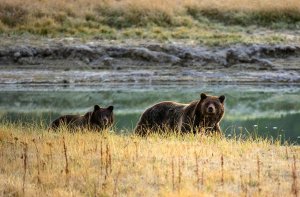The grizzly bear is a well-known California symbol. After all, it’s on the state flag. But the only place you’ll find them in California is at the San Francisco Zoo. A conservation group believes they should be brought back into the wild, ideally in the iconic Sierra Nevada mountain range.

“We think it’s possible to bring the grizzly back,” said Jeff Miller with the Center for Biological Diversity.
The organization has launched an online petition drive urging state and wildlife officials to consider the feasibility of bringing back the grizzly, which can get up to nearly a 1,000 pounds. About 20,000 people have signed it.
It’s not clear how many bears would constitute a viable population. Proponents say large predators are important to keeping ecosystems in good shape.
“I think the state owes it to the people of California to take a good hard look,” said Miller, who believes that humans would have little to fear because “we’re not a preferred food source.”
It’s believed that tens of thousands of grizzlies roamed California in the early 1800s, but as the population expanded, the animals were systemically killed. The last one in California was shot in the early 1920s.
As a result, grizzlies are on the federal list of threatened species. They can be found in just a few states: Wyoming, Montana, Idaho, Washington and Alaska.
There is precedent for returning animals to the wild.
Yellowstone National Park reintroduced gray wolves into the park in 1995 after they, too, had been killed off a century earlier. Scientists are still debating their impact, but it’s generally accepted that they have helped other carnivores thrive because of leftover carcasses that are then feasted on by other animals.
The reintroduction process generally involves identifying healthy animal populations in other regions and capturing them. Scientists will sometimes initiate captive breeding and then will release enough animals to jump-start a wild population. In the case of grizzlies, it’s not clear what number that would constitute, but the bears would be closely monitored, likely through radio collars.
Even so, it appears that California officials have little appetite to see grizzlies back in the Golden State. They fear they would stray into populated areas.
“The idea has been a nonstarter,” said Jordan Traverso, deputy director of communications for the California Department of Fish and Wildlife.
California is home to black bears, and state wildlife officials say they rummage through garbage, campgrounds and sometimes break into homes to find food.
With nearly 40 million people in the state, Traverso argues that there is nothing to suggest grizzly bears would remain in isolated areas — noting that bears traditionally roam oak woodlands and even beaches and eat whale carcasses.
“We already have plenty to do with animals that currently exist in the state,” she said. Officials also are concerned about the potential impact on livestock.
Miller knows that getting the state to reverse course is a long shot, but says a feasibility study is in order.
“I think if we want to retain some of the wildness and some of the untamable spirit of California, I think the grizzly is a person icon for that,” he said.














